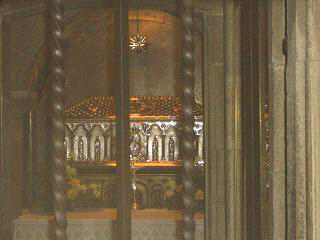Santiago's history and early origins
Many cities have interesting origins and great stories associated with them, but this one about Santiago, which is historically supported, is one of the best.
All serious records about Santiago de Compostela commence around the ninth century which coincide with the discovery of the remains of the apostle, Saint James, in the vicinity where the city now lies.
The Saint James connection
Saint James, one of Jesus's disciples, arrived in Spain in order to follow his late master's wishes and spread the Gospel and Christian faith around the world. He preached throughout Spain (then called Hispania), and some of his more regularly used preaching platforms, such as the one in Padron, can still be seen today.
On returning to Jerusalem St. James was beheaded, but some of his followers brought his body back to Spain docking at the port town of Iria Flavia (now Padron). From there they took his body, by cart, to a burial spot close to some old Celtic ruins in an area known as Libredon. Two of his aides remained to guard his mortal remains and were, after their deaths, interned either side of him.
As the years, decades and centuries passed, all record and memory of Saint James' burial spot was lost or muddied. Today this seems hard to believe, but Hispania was constantly at war and under foriegn occupation. In the years immediately following his death, Rome oppressed and persecuted followers of Christianity and, in later centuries, the Barbarians and Moors invaded and sacked parts of what is now Spain, even extending up to Galicia.
By the eighth century, all that remained of St. James' grave were stories and folk law that suggested his remains lay near a place known as Libredon. His physical resting point was however lost, probably buried or overgrown after centuries of neglect.
The discovery of the tomb
In the ninth century however, things were about to change and the apostle's tomb was found by nothing less than a miraculous event.
A hermit called Pelagius saw unusual lights and heard strange noises which appeared to come from a point in a nearby wood in the vicinity to which it was rumoured St. James was buried. Concluding that this was a sign from God, Pelagius informed the bishop of Iria Flavia, Theodomir, of what he had witnessed. The bishop and his aides then travelled to the spot highlighted by Pelagius and a successful search was made for the ruins of a small building in which Saint James's remains were said to be laid. When the building was found it became clear that there were three separate bodies, just as ancient accounts suggested, and that one of them was given prominence over the other two. The Bishop declared that the tomb of St. James had been discovered and that the apostle's former aides, Theodore and Athanasius, lay either side of him.
Much activity followed including a visit by King Alfonso II who instructed that a basilica
 or church be built over the apostle's remains. One dozen monks were also given the mission of supervising and guarding Saint James' place of internment and their community and monastery became the starting point for what is now Santiago de Compostela.
or church be built over the apostle's remains. One dozen monks were also given the mission of supervising and guarding Saint James' place of internment and their community and monastery became the starting point for what is now Santiago de Compostela.
Right is the actual tomb of Saint James in Santiago de Compostela cathedral. It is on public display and any visitor is free to take a look or photograph it.
The name Santiago de Compostela
There is no definitive explanation as to how the city's came by its name, but in keeping with the documented story above, the lights that the hermit saw can be described in Latin as "Campus Stellae", translating to "field of stars" and this is where it is thought "Compostela" may originate. A further historical fact supporting this story was the uncovering of Bishop Theodomir's tomb under the "now" cathedral of Santiago de Compostela in the nineteen fifties. The Bishop expressly requested that his remains be buried close to those of St. James and an inscription on his tomb gives a date of 847 AD which equates perfectly with the events in the story above.
To find out about "The way of St James" pilgrimage, click this Camino de Santiago link.
This page and other pages in this section were researched and written by M. Lambert. This page was first published in 2004 and it has been updated in 2005, 2007 and 2010.
Return to the Santiago de Compostela index page
Is the Santiago and St. James tale nothing more than a popular myth, or even part of a conspiracy?
- For an alternative, contrary and rather cynical view of the account above take a look at www.sacredsites.com. The page to which this link leads tells a story of ecclesiastical trickery, corruption and conspiracy in the creation and fostering of the St. James legend in Galicia.
Personally I would like to think that the churches tale is the true one, but who knows! is it fact or fiction?

